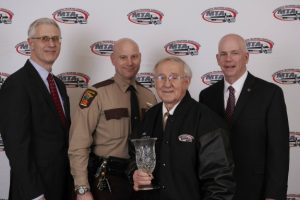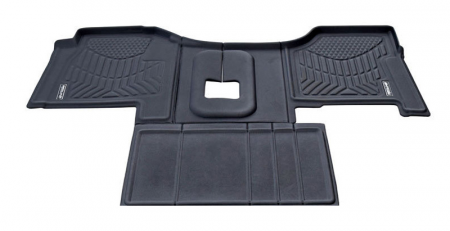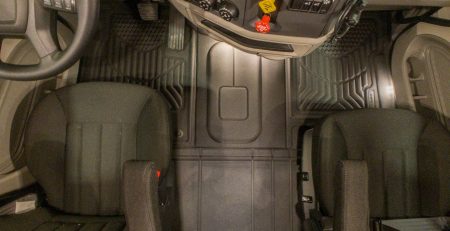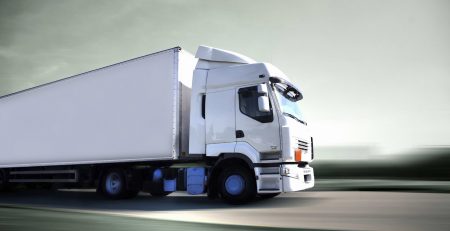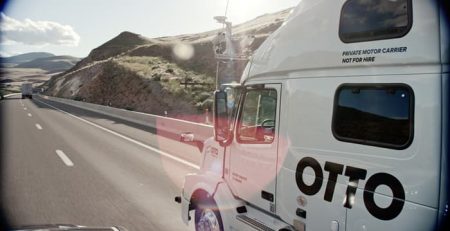Many Tools And Devices In Trucking Originated With The Military
 The relationship between the military and the trucking industry goes back to World War I. In 1917, even before the United States entered the war, Mack ACs were used to bring supplies to British troops. Because of their incredible (for the time) ruggedness and reliability under the most adverse conditions, the Brits called them “Bulldog trucks.”
The relationship between the military and the trucking industry goes back to World War I. In 1917, even before the United States entered the war, Mack ACs were used to bring supplies to British troops. Because of their incredible (for the time) ruggedness and reliability under the most adverse conditions, the Brits called them “Bulldog trucks.”
Two years later, the U.S. Army convoyed across the U.S. following the Lincoln Highway (now I-80 and U.S. 30) to test its mobility under wartime conditions. There were 81 vehicles and 300 men. Among them were Mack and Packard tire repair trucks, rolling machine shops and blacksmith shops, and even a rolling medical clinic. It took “just 56” travel days, as the convoy made its way through rough and often impassable roads.
An official observer on the trip, Lt. Col. Dwight D. Eisenhower, never forgot the lessons of that trip and, in 1956, as president of the United States, he created our interstate highway system. Without it, trucking as we know it would not exist.
Better roads are not our industry’s only legacy from the military. Many developments in our safety, security and even comforts are direct offshoots of military technology.
Communication
As intercity trucking grew, drivers recognized each other by momentarily flashing or dimming their headlights, even before the days of high and low beams. One flash recognized a fellow trucker. Two generally signalled a police presence within a mile or two, and three or more warned of imminent danger ahead — a crash, a bridge out, construction.
A better system emerged thanks to the hastened development of two-way radio communications during World War II. After the war, hobbyists were using low frequency radio for personal communication. In 1958, citizens band (CB) radio was created, and allowed anyone to get a license to operate it, without having to learn Morse Code. Later, the FCC dropped the licensing requirement.
It didn’t take long for truckers to adopt the CB as a way to replace flashing lights.
Safety
The next military technology to be adapted by trucking was radar. The initial purpose was Radio Detection and Ranging (hence RADAR), a means of detecting and locating enemy aircraft and ships. High energy radio waves were broadcast. When those waves were reflected back from objects, computers calculated their location, direction and speed. Defenders could take countermeasures. Adapted to trucking in the 1990s as Vehicle On-board Radar, or VORAD, early versions issued alerts using lights and sounds to warn of a slower vehicle ahead. As computer technology advanced, VORAD was integrated with cruise control to give us adaptive cruise control.
With cruise control set, the truck continues at cruising speed until a slower object is detected ahead. Then the cruise control adapts to traffic, de-fueling the engine to slow the truck and maintain a two-second following distance. If the traffic ahead speeds up so does the truck, up to its preset speed. If traffic stops, adaptive cruise control warns the driver. If the driver pulls out to pass the slower vehicle, speed resumes. The system stops when the brakes are applied. The newest versions will autonomously apply the service brakes if needed.
RADAR technology also propels blind-spot detection. Using microwave radio or sonar (similar to RADAR but using sound frequencies above human hearing), these short-range units scan for objects in areas hidden from sight. When signaling for a lane change, audio alerts may be deactivated but warning lights still flash.
Another advance designed to locate targets at long distances or low visibility, optical recognition systems use cameras to determine shapes and positioning. The technology led to lane departure warning systems that monitor the road markings and traffic, and alert you if you are drifting out of your lane. These, too, deactivate when signaling an intentional lane change. With the development of electric power steering systems, computers can keep a vehicle centered in its lane with minimal driver input.
Tires
Considering how many military vehicles operate in combat zones where a flat tire could make a vehicle a sitting duck for enemy fire, it makes sense that tire manufacturers developed a solution. Run-flat tires can be punctured by a .50 caliber (half-inch diameter) bullet and still retain their shape.
Moving fast and steadily is important in every situation, so military vehicles operating off-road improve traction by lowering tire air pressure to enlarge the footprint. A method was needed to reinflate tires once on-road operation continues. Eaton developed a remote-controlled system to lower and raise tire pressures to resolve that issue. Their system, now made by Dana, is the Spicer Central Tire Inflation System.
Of course, on-highway civilian trucks don’t need to deflate tires, but under-inflation is the prime cause of truck tire failures. That need led Pressure Systems International to create a pressure maintenance system for trailer tires. The Aperia Halo system and AIRGO’s T3 both maintain pressure in drive axle tires.
Lights
In combat, the use of infrared scopes and heat-seeking missiles means a vehicle’s heat signature affects vulnerability. Naturally, techniques to minimize heat emerged. Electric motors replaced power take-offs, reducing main engine use. Light-emitting diodes (LEDs) are replacing incandescent headlamps, significantly reducing heat. Today, truckers realize the benefits of increased life, greater brightness, and lower maintenance and replacement costs from LED forward lighting.
Satellite technology
Aerospace technology brought us literally hundreds of satellites circling the earth, and it’s no secret that they come in handy for military operations and intelligence. Satellites can gather and convey information in real time, which is key to reconnaissance, navigation, meteorology and more.
Qualcomm, founded in 1985, used the same digital wireless technology that the military used for secured communications and applied it to the transportation industry.
Many veteran drivers have horror stories of spending their entire break or meal time standing in line at a truckstop, waiting to get to the banks of phones so they could call in to their dispatchers. Drivers who had Qualcomm units installed in their cabs bypassed that problem. Qualcomm brought messages, route changes and traffic alerts right into the cab.
Global Positioning Systems (GPS) also started as military equipment. At first, errors were deliberately built into the systems to prevent enemies from pinpointing our position. Today, civilian GPS units don’t have that concern and can find our locations within just a few feet. Huge databases were compiled on everything from alleys to interstate highways.
Specialist companies provided data previously available only in truckers’ road atlases. Before, drivers used their Rand McNally to look up mileage tables, low underpasses, highway restrictions and a host of other things. Now, Rand McNally, Garmin, Cobra and Magellan have all that in their databases. Route calculations automatically avoid low underpasses and truck restrictions, by class and size of truck.
The latest use of GPS data is the use of terrain in cruise control. Pioneered by Daimler, the cruise control reads land contours and “knows” when to add throttle or back off, depending on the earth’s contours and change in speed limits up ahead.
For load safety and equipment security, a recent development involving GPS is trailer tracking. Back in the day, fleets with multiple trailers per tractor often lost track of individual trailers. Now, using computers and GPS, tracking is simple.
Satellites also brought us satellite radio. Last century, to listen to the radio when traveling cross-country meant changing stations every hour or so, with limited program choices, if you got any reception at all. This century SiriusXM broadcasts via satellite to virtually the entire country. There is something for everyone: music by the decade, country or bluegrass, classical or opera, political talk shows, adult or family comedy, kids’ programs, news and finance and sports galore. There is even a trucker’s channel.
So this Veterans’ Day, remember that the military brought us so much more than disciplined veterans to fill drivers seats and keep our trucks rolling. It gave its technologies to make trucking safer, more efficient, more reliable and more comfortable for all of us. When you see someone in uniform, thank them for keeping us safe and for the benefits of freedom that we enjoy. And on November 11, thank the folks in the veterans’ caps and jackets, too.
Source: http://roadking.com/trucks/many-tools-devices-trucking-originated-military/
Visit us:
301 W Gerri LnAddison, IL 60101
Contact us:
Phone: +1 224 422 2829
Mail: info@tire-max.com


